| 1 | An easily confused killer |
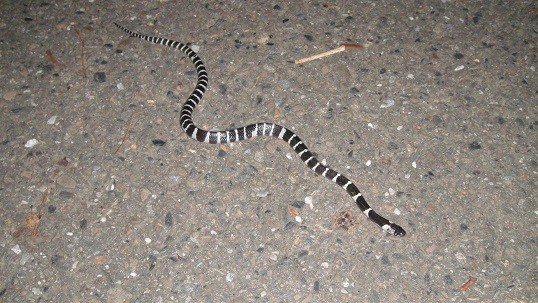
There are many reasons not to walk into a random marsh in southeast Asia without doing your homework, and one of the best is the many-banded krait (Bungarus multicinctus). This 1-1.5 metre snake is part of the 16-strong Bungarus krait family, all of which are highly venomous. Drop for drop, the many-banded krait may be the most venomous member of all, and they’re also one of the more widespread, inhabiting Taiwan, Hong Kong, the southern regions of China (Gunagdong, Hainan) and Vietnam.
There are some relatives they could never be confused with, such as the Ceylon krait which lives exclusively on Sri Lanka, or the red-headed krait with a red head. However, they’re easily confused with the banded krait (B. fasciatus), as their range overlaps in southern China. The key is colour, as the white patches on the many-banded krait are pure white, while the banded krait’s are yellow tinged.
Many-banded kraits were first discovered in 1861, and have a thin, sleek body. Their scales have a shine, and their eyes are beady and black, with pupils almost blending in completely.
| 2 | One of Earth’s deadliest venoms |
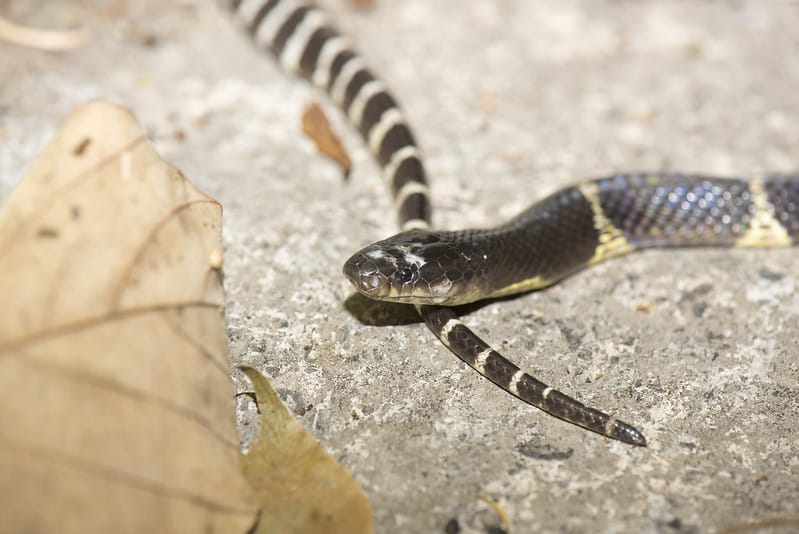
Compared to its relative the banded krait, Bungarus multicinctus has a significantly lower venom yield, of just 4.4mg versus 22.7mg. However, the LD50 toxicity rating is significantly higher. Banded kraits reach 1.2mg, while the many-banded krait scores as low as 0.07mg. This makes it one of the most venomous land snakes in the world. The inland taipan of Australia comes first at 0.025mg, while the eastern brown snake ranks second at 0.05mg.
Many-banded kraits cause 7.5% of all snake bites in Taiwan, and the mortality rate when untreated with antivenom (doctors give 4 vials as a standard) is 25-35%. This is mostly a neurotoxic snake which kills through respiratory failure.
Fortunately, nature has a counterbalance, as the many-banded krait isn’t aggressive. They’re timid and shy, and like to take shelter under rocks. It’s mainly touch that sends them into a savage aggression spiral, and picking one up is effectively suicide. Another saviour is that antivenom is stocked in hospitals all across southern China, and the antivenom is particularly effective, leading to rapid recovery (if administered quickly).
| 3 | Specialises in neurotoxins |
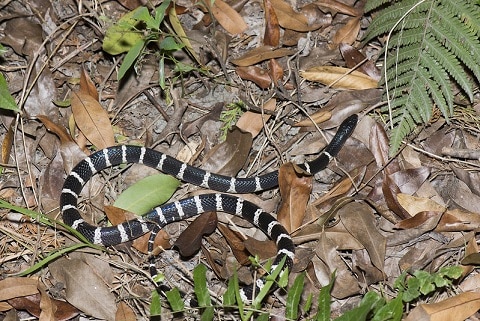
Bungarus multicinctus is officially the most neurotoxic snake on the island of Taiwan. The Chinese cobra and Chinese moccasin also possess neurotoxins, but they barely affect humans. Those snakes are more famous for their massive skin necrosis and swelling.
Many-banded kraits meanwhile, are the opposite. The bite is a mere pin prick, with no aggressive savagery or grisly ripping of flesh. There are few local symptoms, mainly a slight itchiness and numbing. In a study from Taiwan, 20.5% of victims suffered no symptoms beyond local. However, 27.3% suffered widespread pain, and 27.3% suffered respiratory failure.
This is a speedy snake, as all cases of respiratory failure developed within 1.5 to 6.5 hours. In the Vietnam war, soldiers nicknamed it the “two-step” snake, as two steps would be the future span of your life. A resting soldier would awaken with a start if he sensed this black and white serpent crawling its way towards him.
| 4 | Exercise pain to the max |
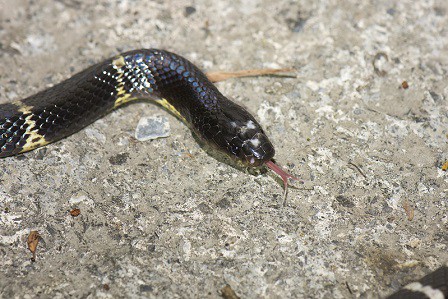
Despite the lung failure risk, the signature symptom of many-banded krait venom is more unique. It’s famous for causing muscle pain in random places, but rather than stabbing or burning pains, this has been described like the muscle aches after a heavy gym session, turned up to the maximum, across the whole body.
Anti-inflammatory drugs (NSAIDs) failed to relieve the pain, and scientists still aren’t sure of the cause. They believe that a physical, enzymatic property of the beta-bungarotoxins could attack muscle cells directly. Only the opioid tramadol gave the patients any relief.
The pain was concentrated in the limbs, eyes, abdominals and neck, but the back was spared for some reason. Another common symptom is dilated pupils, and this correlated with respiratory failure. The eyes became fixed, staying dilated regardless of light. Many banded krait venom also causes haywire taste buds, with food becoming flavourless. A many-banded krait bite can send your heartrate to over 100 beats per minute. Other standard symptoms include nausea and vomiting.
| 5 | 20% of bites are dry |
By weight, over 50% of many-banded krait venom is composed of one toxin class: beta-bungarotoxins. The other main class is the alpha-bungarotoxins, and both are neurotoxins. These only appear in the Bungarus family of snakes, also including Malayan kraits and banded kraits.
The two cooperate to unleash a dance of death, as alpha-bungarotoxins target nicotinic AChR receptors in muscles, to prevent brain signals being received. The beta-bungarotoxins act pre-synaptically, targeting the neuromuscular junction and damaging nerve endings. There’s also the mysterious κ-bungarotoxins, but these only make up 0.1% of the venom.
The same study on 44 patients in Taiwan found that 29 were bitten on the upper limbs. These were mostly males, and were trying to pick the snake up, in locations like their gardens and yards, roads, and farms. With 20.5% of victims suffering no effects, this is a snake you can survive if the dice land in your favour. It isn’t a guaranteed death sentence, as a healthy proportion may be dry bites.
| 6 | Calm, but not cowardly |
Some snakes move fast, like they’re buzzed up on caffeine (see the nearby oriental ratsnake), but the many-banded krait moves slowly and deliberately. They’re a nocturnal snake, which reduces encounters with people.
Many-banded kraits rarely act like a cobra and rear up and hiss when you’re still several metres away. They won’t charge as you back off with your hands held up pleadingly. However, when they do get bothered, they often skip the defensive stance and launch straight into attack, without warning.
Many-banded kraits can strike from multiple directions. They also have a notorious ability to twist their jaws and bite, even when the back of their head is firmly gripped. In Hong Kong, they’re often encountered in water culverts at night, or in old buildings at the edge of forests. Drunken kids flocking to those stone ruins might be at risk from this venomous snake.
Being so deadly, it was wise millions of years ago for non-venomous snakes to mimic the many-banded krait. One example is the Futsung wolf snake, which lives in Hong Kong. Its white and black bands are extremely similar, with the difference being a smaller number of bands.
| 7 | Diet: mostly other snakes |
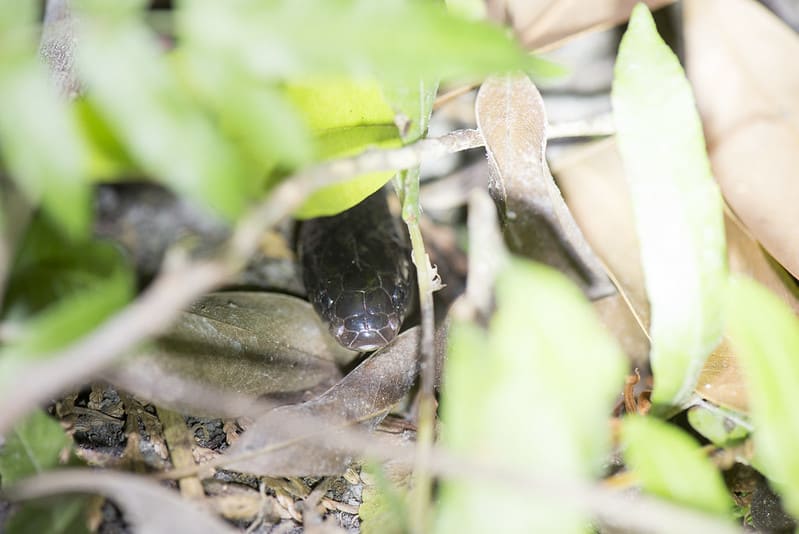
The many banded krait has a strange requirement: it likes food in a cylindrical shape. For decades, it was reported that while most Bungarus kraits ate other snakes, Bungarus multicinctus was a rare one to eat fish. This stemmed from a 1970 study from Taoyuan County, China, where 63.16% of its diet was fish and 34.21% other snakes.
However, a 2010 Taiwanese study found that it mostly ate snakes after all. Lizards and fish made up a much small number, and the common characteristic was that all prey were long and thin. Its single most common meal was the rice paddy snake (Hypsiscopus plumbea). This also favours wet habitats like marshlands, so the two interact constantly. Rice paddy snakes are thick, and have a slimy brown back and a yellow underside.
10 other snake species were found in its belly, including the checkered keelback and greater green snake. However, there were no mammals. Many-banded kraits dislike mice, and will reject them in captivity. It’s also rare for them to eat frogs and toads in the wild. Many-banded kraits also fall victim themselves, as in July 2019, one was spotted being eaten by a king ratsnake (Elaphe caritina).
| 8 | Popular in Chinese medicine |
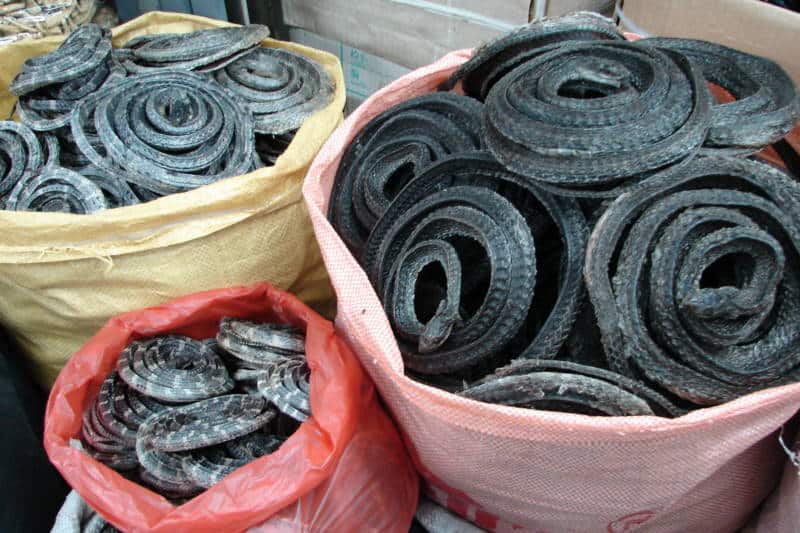
Young snakelets are used, which harvesters track down in summer or autumn. The fangs are removed, and their abdomens cut open and hollowed out. The many-banded krait is then washed with 75% ethanol. The small snake is curled into a flat circle, with its head at the centre and the tail inserted neatly into its mouth. This shape is adjusted with thin bamboo sticks, and the coiled krait is roasted and dried at low temperatures.
Guangdong province is the top area of production for this pocket sized remedy, particularly Shantou and Mei county. The dry, circular krait discs are 3cm in diameter, smell fishy, and taste salty and sweet. To heal their woes, customers are advised to remove the head (which still contains venom) and scales, mix 3-6 grams into water, and consume.
| 9 | Comparison: other Bungarus kraits |
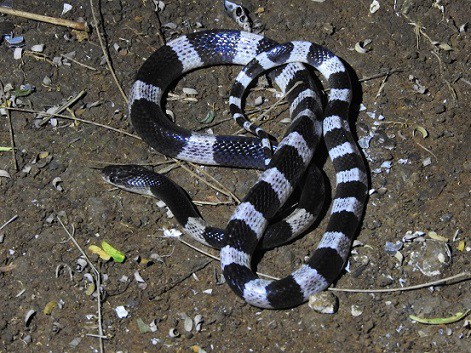
Within the 16-strong family, the many-banded krait’s closest relative is Bungarus candidus, AKA the feared Malayan blue krait. The latter lives further south, including Malaysia, Indonesia and most of Thailand, while the many-banded krait just crosses into northwest Thailand. The two look very similar, but the many-banded krait has extra bands: 42-60 versus less than 40. Many-banded kraits also have wider black bands than white, whereas the Malayan krait has more even spacing. These two are also closely related to the greater black krait (Bungarus niger), which inhabits northeast India.
Bungarus multicinctus was once notorious as the species which killed respected herpetologist Hoseph Slowinski. He was bitten on an expedition to remote Myanmar in September 2001, and died 29 hours later. In 2021 though, this snake was re-examined and proven to be a new relative: Suhzen’s krait, with broken white bands in the centre. This brought the family to 16 members.
Many-banded kraits aren’t particularly long-lived, as the oldest on record reached 13.7 years. They’re an egg-laying snake, which lays a maximum of 20, usually 3-15.
| 10 | Prefers marshland (but flexible) |
Many-banded kraits are able to withstand many habitats. They generally prefer areas with decent moisture, and you’ll never find them in rocky canyons or dry semi desert. They can appear in ponds, streams, marshes, agricultural fields, bamboo stands, rice paddies and ditches. They can even appear in coastal rainforests and deciduous forests. Nevertheless, many-banded kraits are usually found near a water body, and marshland is their absolute favourite.
For example, one of their bases is the Mai Po Marshes of Hong Kong. These are internationally protected wetlands which are home to nearly 100,000 migratory birds, many endangered, and is fully controlled by WWF Hong Kong. The marshes are popular for student tours, although they may not know the krait danger that awaits. They share these protected marshes with Chinese cobras, oriental ratsnakes, checkered keelbacks, and mangrove water snakes (Enhydris bennettii).
Bungarus multicrcula rarely appears at high altitude, with 700 metres being limit. They’ve been spotted high in mountains occasionally, but it’s believed that religious fanatics had released them onto remote trails.
